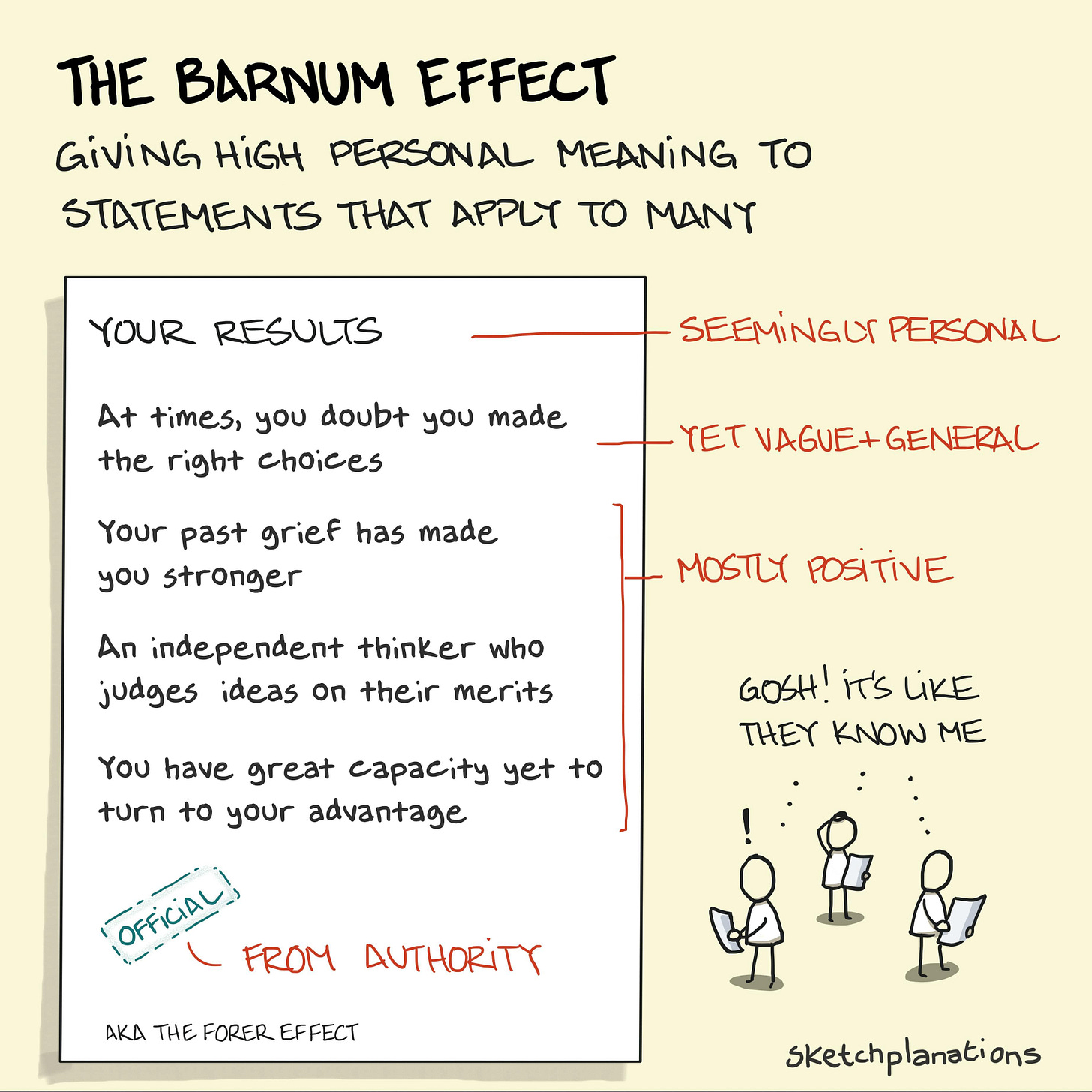Mastering the Forer-Barnum Effect: The Hidden Psychology Behind Every Successful Product
Explore how companies use the Forer-Barnum effect to create 'personalized' experiences. Learn the psychology behind successful product marketing and user engagement.
Hello and welcome back to another fresh episode of Tech Trendsetters, where we uncover the hidden forces shaping our industry and equip you with the knowledge to stay ahead of the curve. Today, we're diving into a fascinating psychological phenomenon that I believe every professional should understand – the Forer-Barnum Effect. And trust me, once you see it, you won't be able to unsee it!
You've probably heard me talk about various productivity hacks and cognitive biases before. But this one's special because it explains so much about why certain marketing tricks work, why some HR practices are the way they are, why we buy stuff we didn’t want to buy, and – let's be honest – why we all sometimes fall for what is essentially clever nonsense.
In this episode, we'll explore:
How does our critical thinking suddenly give way to the desire to be deceived? (Trust me, it happens to the best of us)
Where and how is the Forer-Barnum effect being used? (Spoiler: pretty much everywhere in modern tech and business)
What principles make it work so effectively? (And yes, I'll show you how to spot it)
I've had this topic on my mind a lot lately, and I want to share what I've found in a way that will make it impossible for you to unsee it in your daily life. So let's get started!
Let's Talk About Professional Nonsense
Let me start with first with what professionals call "implicature".
Officially, according to wikipedia "implicature" is something the speaker suggests or implies with an utterance, even though it is not literally expressed. Sounds fancy, right? Well, in reality it's just a sophisticated term for well-crafted nonsense.
So the thing is – this nonsense works exceptionally well. Not just well – it works so well that people keep coming back for more, often willing to pay good money for it! Whether it's in advertising, HR, IT or psychological consulting, people are literally asking for more of this carefully crafted vagueness.
But before you think I'm just here to criticize, let me tell you something – I use it too. We all do, especially in tech and business. The trick is knowing when you're using it and, more importantly, when it's being used on you.
Barnum-Forer Effect
Scientists actually argue about what to call this effect. You might hear it referred to as the subjective confirmation effect, the Barnum effect, the Forer effect, or the Barnum-Forer effect. Honestly, the name doesn't matter as much as the story behind it.
The whole thing started with what I call “honest implicature” – when someone actually tells you they're going to trick you.
So, what happened: Phineas Barnum put fortune tellers in his circus. Volunteers would be called on stage and, to their amazement, would discover that the fortune teller's card predictions actually applied to them. Even the biggest skeptics in the audience had to agree with some of the statements. The shows became so popular that getting tickets was nearly impossible whenever the circus came to town.
The real secret behind these performances was the nature of the predictions themselves. The fortune tellers used statements that felt highly personal but were actually broad enough to apply to almost anyone. People instinctively sought meaning in the descriptions, interpreting them in ways that felt specific to their own lives. For example, a statement like, "You sometimes feel unsure of yourself but put on a confident front," would resonate with nearly anyone. This psychological tendency – our inclination to see vague statements as uniquely applicable – is what we now call the Barnum effect.
When Science Got Involved
This could have remained just a circus trick if it wasn't for Bertram Forer, a psychologist who decided to test this phenomenon properly. In 1948, he tried something with his students that I find absolutely brilliant in its simplicity.
First, he gave them a personality test. But instead of actually analyzing their answers, he just grabbed some random horoscope statements from the local newspaper. The next day, he handed each student their "personalized" results and asked them to rate how accurate they were.
Want to guess what happened? Not only did everyone find "their" description accurate, they rated it 4.26 out of 5 on average. That's an 85% accuracy rating for random horoscope snippets!
Forer's experiment has been repeated by many other researchers. In some cases, participants were asked to choose the most relevant description between receiving a real psychological test and correctly composing a generic universal formulation. Guess what the results were.
Modern Day Magic of Implicature
You know what's funny? This same trick is everywhere in our tech world today. When LinkedIn shows you a "perfect job match," or when Netflix tells you "Because you watched..." – that's the Forer-Barnum effect in digital form. And we fall for it every single time.
Think about it: whenever an advertisement shows a "good housewife" or a "real dad" making "the right choice," consumers feel it's about them. We all think we're good, we're real, and naturally, we should buy those "right" products too. I catch myself falling for this all the time, especially with tech gadgets. "This is exactly what a productive professional needs!" Yeah, right.
Who's Using It?
All politics (both corporate and government), all show business, infobiz, advertising, sales, the beauty industry, all media, and now even AI-based assistants, in short, everyone who has to create an impression, do so using the Forer-Barnum effect.
I can confidently say that you, dear reader... No, not someone else reading this. I mean you specifically. You're the kind of person who sees patterns others miss… Who has this incredible untapped potential in technology and leadership. And you know what? That breakthrough project or career move you've been contemplating? It's closer than you think.
I notice you tend to over-analyze your technical decisions and management choices – probably because you hold yourself to incredibly high standards. Your strong sense of what's right in tech and business drives you to seek the most ethical and efficient solutions. That's why you're here, reading Tech Trendsetters – because deep down, you know that understanding these hidden patterns and psychological principles will help you unlock your next level of success.
Feels good, right? And don’t even try to lie to me that it doesn’t. So, you get the idea and can continue this pitch on your own. The main thing is to follow a few simple rules.
The Simple Rules Behind It All
Let me break down the principles that make this psychological trick work so effectively:
To make a person turn off their critical thinking, you must speak directly about them. This sounds paradoxical, but it works brilliantly if the statements are framed positively. Even a phrase like "I agree with you..." successfully bypasses most mental filters.
People who trust astrologers believe in horoscopes. People who trust scientists believe in research. And so on. The source must align with the target audience – once that is in place, you can say anything.
The subject is better than they think they are, and tomorrow they will be even better than yesterday. More positivity and optimism! People love it.
We are all unique, with rich, unparalleled inner worlds. If you sense this uniqueness, even the most skeptical hearts will open to you.
Confirm expectations: Good deeds will be rewarded. Evil will be punished. Understanding will come. We are on the right side. Difficulties are temporary.
These are just general rules, but it’s not really hard to adapt them to apply to your business. For example:
Speak directly to your customer (and bypass their critical thinking) – use direct, personalized language in sales pitches, emails, and marketing campaigns. Instead of talking about the product, talk about the customer.
Match the source to the audience. Your brand voice and messaging should align with your audience’s beliefs. If they trust data, use statistics. If they trust influencers, use testimonials.
Boost Their Self-Image. Make your customers feel like they’re already making smart, forward-thinking decisions just by engaging with your brand.
Validate Their Uniqueness. People want to feel special. They don’t want to be "just another customer" – so treat them like they’re one in a million.
Confirm Their Worldview (And Reduce Decision Anxiety). People want to believe that good decisions lead to rewards and that their struggles will pay off. Reinforce this belief in your messaging.
TLDR;
When a person deceives themselves, they hope that the deception will become reality. When deceiving others, they hope the truth will never come out. In any case, they are trying to change something. And that's admirable!
Think about it: every "personalized" recommendation, every "perfect match" job description, every "tailored just for you" advertisement – they all work because we want them to work. We want to believe we're special, that we've found exactly what we need, that this product or service will make our lives better.
And you know what? Sometimes it actually does! Because when you understand how the Forer-Barnum effect works, you can use it not just to sell, but to genuinely connect with your audience. To help them see the value in what you're offering. To make your message resonate.
The key to remember: it's not about tricking people – it's about speaking to their genuine hopes, needs, and aspirations. Understanding human psychology is the first step to creating something truly meaningful. And sometimes, that's exactly what people are looking for. Thank you for joining me today, and see you in the next episode!
🔎 Explore more:




